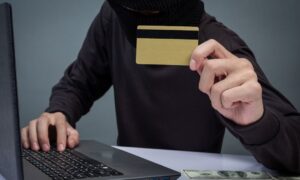Let’s dive into a straightforward guide about securing your bank account from risks. Whether you are an experienced online banking user or stepping into digital finance, the points below will provide essential understanding and methods to solidify your financial shield against online dangers. Discussing sturdy password usage to modern two-step verification processes, come with us on a trip to boost your bank account’s safety and achieve a worry-free digital life.
What Is Data Security at Banks?
Banks implement comprehensive measures to safeguard sensitive data from unauthorized access or misuse. It protects customers’ personal and financial information. Robust security maintains customer trust and protects their assets.
Traditional or alternative lenders providing regular personal loans or payday loans with guaranteed approval decisions must vigorously protect personal data. Such services deeply assess financial histories, accessing sensitive details. Thus, sturdy encryption, access controls, and secure authentication are crucial. With guaranteed decisions, safeguarding individuals’ account information is paramount.
Banks must implement secure channels for online applications, ensuring encrypted data transmission to prevent interception by malicious actors. Also, they need stringent identity verification measures to confirm loan applicants’ legitimacy and to avoid fraud.
Is My Savings Account Safe from Hackers?
You need to keep your savings account secure, especially in these times when we do so much online. Here’s how banks help protect your money from digital dangers:
- Encryption Technology: Banks shield data sent from your device to their systems with solid encryption. It means your info stays private and secure.
- Multi-Factor Authentication (MFA): Most banks use multi-factor authentication. You’ll have to prove your identity in two or more ways to get into your account. This extra step stops others from getting in.
- Secure Login Credentials: You must create solid, unique passwords for your online bank accounts. Don’t use easy-to-guess details, and change your password often. Some banks can also use features like fingerprint or face scans.
- Fraud Monitoring: Banks use complex systems to watch for strange account activity. If they see suspicious actions or weird transactions, they’ll alert you and look into it. With help of such information you can prevent hackers from accessing your bank account for example by remotely logging them off.
- Regular Software Updates: Banks often update their systems to fix weak areas and improve security. Ensure your devices and banking apps always use the latest updates for the best protection.
- Alerts: Set up alerts for specific happenings like significant transactions or login tries. This way, you’ll see any unauthorized access fast.
- Safe Networks: Don’t use your savings account on public Wi-Fi; it’s risky. Always use secure, friendly networks for essential money matters.
- Insurance: Many places have deposit insurance for bank online failures. It’s good to know what insurance your bank has.
These steps make your savings account safer, but it’s also essential to be watchful. Always check your account, quickly report strange activity, and keep learning about cybersecurity. Also, talk to your bank about their security measures to protect your money.
Bank Account Security Risks of Using Online Banking
Web banking is handy and easy, letting people handle their money from home. But, one needs to know about some security problems it may bring. Here are a few risks of using web banking:
Losing Your Identity
Web banking profiles could be a target for online thieves who want to steal private details. If they succeed, they could gather your usernames, passwords, or account numbers, which might result in identity theft.
Trick Emails
Phishing is a trick where the bad guys use fake emails, messages, or websites to fool people into giving private details. Web banking users might get bogus emails looking like they’re from their bank, making them key in login info on scam sites.
Harmful Programs and Bugs
A harmful mobile app can affect computers or mobile devices, threatening the safety of web banking. Some programs, like keyloggers, record what you type and capture login details without knowing it.
Wi-Fi Safety Worries
Using unprotected or public Wi-Fi can be risky as these networks can easily be intercepted. Digital trespassers can find flaws in the virtual private network to steal private stuff that’s sent from your device to the bank’s server.
Simple Passwords
Those using easy-to-guess passwords make their accounts vulnerable. A robust and unique password is critical to keeping bank information secure.
Don’t Leave Access Open
Not signing out or stepping away from your gadget could let others sneak into your online personal information through fraudulent practices. It’s critical to always sign out right and lock your gadgets with a password or fingerprint scan.
Keep Your Tech Up-to-Date
Forgetting to update your operating system, web browser, and antivirus program can create we-ak spots that cyber-thieves might target. Regular updates fix these weak spots and boost the online banking security of your online banking work.
Monitor Your Account Well
You might miss fishy transactions if you check your account activity infrequently. Quick ide-ntification of unauthorized access or dealings is critical to stop potential losses.
Watch Out for Trust-Tricks
Cybercrooks might manipulate you to cough up confidential details using trust tricks. They might pretend to be trustworthy to extract sensitive info over the phone or via other communication routes.
To cut down these risks, users should keep their eyes peeled, use stout security measures, turn on two-factor authentication, and stay up-to-speed with their bank’s newest security advice. Also, using trusted and current security software can improve the security protocols of your online banking work.
Tips to Protect Your Bank Account
Keeping your bank account secure is vital in this digital era. Here’s how you can do it in several moves:
- Pump Up Online Banking Passwords. Choose a hard-to-crack password for net banking. Mix capital and small letters, numbers, and symbols to solidify it. Don’t use online banking information like birthdays or common words that can be guessed.
- Two-Step Verification (2SV). Always turn on 2SV. It boosts security with an extra check step, like getting a code on your cell phone, besides your strong password.
- Check Your Accounts Regularly. Keep an eagle eye on bank statements and transactions. Continually check your digital banking activity to spot any strange or unauthorized trades. Contact your bank or credit union instantly via email or phone if something seems off.
- Private Wi-Fi Only. Don’t make monetary transactions on public Wi-Fi networks, as they aren’t safe. Use a personal, passkey-protected Wi-Fi network to access your financial accounts on the internet.
- Watch Out for Phishing Scams. Be careful with emails, texts, or phone calls asking for personal or financial details. Real banks will not demand sensitive data via any unasked for communications. Cross-check any such demands with your bank to confirm.
- Defend Your Gadgets. Get secure passwords by using a password manager or fingerprint recognition for your devices. Download and routinely refresh your antivirus and protective software against harmful threats. Constantly update your operating system and programs to fix security flaws.
- Guard Your Private Data. Be conscious of what you post online and on social platforms. Never disclose delicate things like your bank details, PINs, or responses to security questions. Bad people can use this data to harm you.
- Protect Your Paper Documents. Secure paper documents such as checkbooks, debit/credit cards, and account details. Keep them locked and shred any paperwork with sensitive data before you throw it away.
- Activate Account Warnings. Use the alert service given by your bank. Get notices for big purchases, low balance, or strange happenings. It lets you quickly deal with any significant security issues.
Following these steps, you can reduce the chance of somebody getting into your bank account without permission and keep your money safe. Remember, taking steps before something happens helps to keep your info and money safe.
Bottom Line
In our tech-filled world, protecting your bank account from cyber risks is always essential. Using the strategies mentioned in this guide, you can cut the chance of hackers getting to you quickly. Keep an eye on your accounts, change passwords, and use the newest security from your bank. The secret to safer banking is being active and knowing stuff. It means enjoying online banking but keeping threats low. As tech changes, so should our efforts to keep our money safe online. By doing this, you can boost your bank account’s safety and use technology with trust.




0 Comments